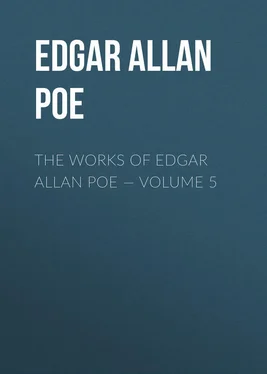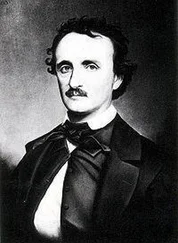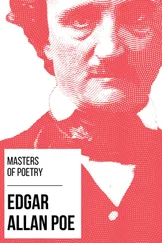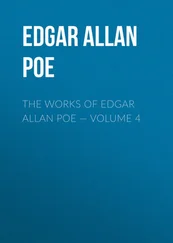Эдгар По - The Works of Edgar Allan Poe – Volume 5
Здесь есть возможность читать онлайн «Эдгар По - The Works of Edgar Allan Poe – Volume 5» — ознакомительный отрывок электронной книги совершенно бесплатно, а после прочтения отрывка купить полную версию. В некоторых случаях можно слушать аудио, скачать через торрент в формате fb2 и присутствует краткое содержание. Жанр: literature_19, foreign_antique, foreign_prose, на английском языке. Описание произведения, (предисловие) а так же отзывы посетителей доступны на портале библиотеки ЛибКат.
- Название:The Works of Edgar Allan Poe – Volume 5
- Автор:
- Жанр:
- Год:неизвестен
- ISBN:нет данных
- Рейтинг книги:4 / 5. Голосов: 1
-
Избранное:Добавить в избранное
- Отзывы:
-
Ваша оценка:
- 80
- 1
- 2
- 3
- 4
- 5
The Works of Edgar Allan Poe – Volume 5: краткое содержание, описание и аннотация
Предлагаем к чтению аннотацию, описание, краткое содержание или предисловие (зависит от того, что написал сам автор книги «The Works of Edgar Allan Poe – Volume 5»). Если вы не нашли необходимую информацию о книге — напишите в комментариях, мы постараемся отыскать её.
The Works of Edgar Allan Poe – Volume 5 — читать онлайн ознакомительный отрывок
Ниже представлен текст книги, разбитый по страницам. Система сохранения места последней прочитанной страницы, позволяет с удобством читать онлайн бесплатно книгу «The Works of Edgar Allan Poe – Volume 5», без необходимости каждый раз заново искать на чём Вы остановились. Поставьте закладку, и сможете в любой момент перейти на страницу, на которой закончили чтение.
Интервал:
Закладка:
Edgar Allan Poe
The Works of Edgar Allan Poe – Volume 5
PHILOSOPHY OF FURNITURE
In the internal decoration, if not in the external architecture of their residences, the English are supreme. The Italians have but little sentiment beyond marbles and colours. In France, meliora probant, deteriora sequuntur – the people are too much a race of gadabouts to maintain those household proprieties of which, indeed, they have a delicate appreciation, or at least the elements of a proper sense. The Chinese and most of the eastern races have a warm but inappropriate fancy. The Scotch are poor decorists. The Dutch have, perhaps, an indeterminate idea that a curtain is not a cabbage. In Spain they are all curtains – a nation of hangmen. The Russians do not furnish. The Hottentots and Kickapoos are very well in their way. The Yankees alone are preposterous.
How this happens, it is not difficult to see. We have no aristocracy of blood, and having therefore as a natural, and indeed as an inevitable thing, fashioned for ourselves an aristocracy of dollars, the display of wealth has here to take the place and perform the office of the heraldic display in monarchical countries. By a transition readily understood, and which might have been as readily foreseen, we have been brought to merge in simple show our notions of taste itself.
To speak less abstractly. In England, for example, no mere parade of costly appurtenances would be so likely as with us, to create an impression of the beautiful in respect to the appurtenances themselves – or of taste as regards the proprietor: – this for the reason, first, that wealth is not, in England, the loftiest object of ambition as constituting a nobility; and secondly, that there, the true nobility of blood, confining itself within the strict limits of legitimate taste, rather avoids than affects that mere costliness in which a parvenu rivalry may at any time be successfully attempted.
The people will imitate the nobles, and the result is a thorough diffusion of the proper feeling. But in America, the coins current being the sole arms of the aristocracy, their display may be said, in general, to be the sole means of the aristocratic distinction; and the populace, looking always upward for models, are insensibly led to confound the two entirely separate ideas of magnificence and beauty. In short, the cost of an article of furniture has at length come to be, with us, nearly the sole test of its merit in a decorative point of view – and this test, once established, has led the way to many analogous errors, readily traceable to the one primitive folly.
There could be nothing more directly offensive to the eye of an artist than the interior of what is termed in the United States – that is to say, in Appallachia – a well-furnished apartment. Its most usual defect is a want of keeping. We speak of the keeping of a room as we would of the keeping of a picture – for both the picture and the room are amenable to those undeviating principles which regulate all varieties of art; and very nearly the same laws by which we decide on the higher merits of a painting, suffice for decision on the adjustment of a chamber.
A want of keeping is observable sometimes in the character of the several pieces of furniture, but generally in their colours or modes of adaptation to use Very often the eye is offended by their inartistic arrangement. Straight lines are too prevalent – too uninterruptedly continued – or clumsily interrupted at right angles. If curved lines occur, they are repeated into unpleasant uniformity. By undue precision, the appearance of many a fine apartment is utterly spoiled.
Curtains are rarely well disposed, or well chosen in respect to other decorations. With formal furniture, curtains are out of place; and an extensive volume of drapery of any kind is, under any circumstance, irreconcilable with good taste – the proper quantum, as well as the proper adjustment, depending upon the character of the general effect.
Carpets are better understood of late than of ancient days, but we still very frequently err in their patterns and colours. The soul of the apartment is the carpet. From it are deduced not only the hues but the forms of all objects incumbent. A judge at common law may be an ordinary man; a good judge of a carpet must be a genius. Yet we have heard discoursing of carpets, with the air “ d’un mouton qui reve,” fellows who should not and who could not be entrusted with the management of their own moustaches. Every one knows that a large floor may have a covering of large figures, and that a small one must have a covering of small – yet this is not all the knowledge in the world. As regards texture, the Saxony is alone admissible. Brussels is the preterpluperfect tense of fashion, and Turkey is taste in its dying agonies. Touching pattern – a carpet should not be bedizzened out like a Riccaree Indian – all red chalk, yellow ochre, and cock’s feathers. In brief – distinct grounds, and vivid circular or cycloid figures, of no meaning, are here Median laws. The abomination of flowers, or representations of well-known objects of any kind, should not be endured within the limits of Christendom. Indeed, whether on carpets, or curtains, or tapestry, or ottoman coverings, all upholstery of this nature should be rigidly Arabesque. As for those antique floor-cloth & still occasionally seen in the dwellings of the rabble – cloths of huge, sprawling, and radiating devises, stripe-interspersed, and glorious with all hues, among which no ground is intelligible – these are but the wicked invention of a race of time-servers and money-lovers – children of Baal and worshippers of Mammon – Benthams, who, to spare thought and economize fancy, first cruelly invented the Kaleidoscope, and then established joint-stock companies to twirl it by steam.
Glare is a leading error in the philosophy of American household decoration – an error easily recognised as deduced from the perversion of taste just specified., We are violently enamoured of gas and of glass. The former is totally inadmissible within doors. Its harsh and unsteady light offends. No one having both brains and eyes will use it. A mild, or what artists term a cool light, with its consequent warm shadows, will do wonders for even an ill-furnished apartment. Never was a more lovely thought than that of the astral lamp. We mean, of course, the astral lamp proper – the lamp of Argand, with its original plain ground-glass shade, and its tempered and uniform moonlight rays. The cut-glass shade is a weak invention of the enemy. The eagerness with which we have adopted it, partly on account of its flashiness, but principally on account of its greater rest, is a good commentary on the proposition with which we began. It is not too much to say, that the deliberate employer of a cut-glass shade, is either radically deficient in taste, or blindly subservient to the caprices of fashion. The light proceeding from one of these gaudy abominations is unequal broken, and painful. It alone is sufficient to mar a world of good effect in the furniture subjected to its influence. Female loveliness, in especial, is more than one-half disenchanted beneath its evil eye.
In the matter of glass, generally, we proceed upon false principles. Its leading feature is glitter — and in that one word how much of all that is detestable do we express! Flickering, unquiet lights, are sometimes pleasing – to children and idiots always so – but in the embellishment of a room they should be scrupulously avoided. In truth, even strong steady lights are inadmissible. The huge and unmeaning glass chandeliers, prism-cut, gas-lighted, and without shade, which dangle in our most fashionable drawing-rooms, may be cited as the quintessence of all that is false in taste or preposterous in folly.
Читать дальшеИнтервал:
Закладка:
Похожие книги на «The Works of Edgar Allan Poe – Volume 5»
Представляем Вашему вниманию похожие книги на «The Works of Edgar Allan Poe – Volume 5» списком для выбора. Мы отобрали схожую по названию и смыслу литературу в надежде предоставить читателям больше вариантов отыскать новые, интересные, ещё непрочитанные произведения.
Обсуждение, отзывы о книге «The Works of Edgar Allan Poe – Volume 5» и просто собственные мнения читателей. Оставьте ваши комментарии, напишите, что Вы думаете о произведении, его смысле или главных героях. Укажите что конкретно понравилось, а что нет, и почему Вы так считаете.












